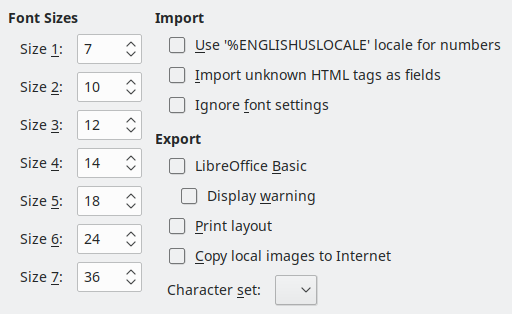HTML compatibility
Defines settings for HTML pages.
To access this command...
Choose Tools - Options - Load/Save - HTML Compatibility.

Font sizes
Use the spin buttons Size 1 to Size 7 to define the respective font sizes for the HTML to tags.
Import
Defines the settings for importing HTML documents.
Use 'English (USA)' locale for numbers
When importing numbers from an HTML page, the decimal separator and the thousands separator characters differ according to the locale of the HTML page. The clipboard however contains no information about the locale. For example, the characters "1.000" copied from a German Web page most possibly mean "one thousand" because the dot-on-the-line is the thousands separator in a German locale. If copied from an English Web page, the same characters stand for the number 1 as in "one dot zero zero zero".
If not marked, numbers will be interpreted according to the setting in Language Settings - Language of - Locale setting in the Options dialogue box. If marked, numbers will be interpreted using the 'English (USA)' locale.
Import unknown HTML tags as fields
Mark this check box if you want tags that are not recognised by Office to be imported as fields. For an opening tag, an HTML-ON field will be created with the value of the tag name. For a closing tag, an HTML-OFF will be created. These fields will be converted to tags in the HTML export.
Ignore font settings
Mark this check box to ignore all font settings when importing. The fonts that were defined in the HTML Page Style will be the fonts that will be used.
Office Basic
Mark this check box to include the Office Basic instructions when exporting to HTML format.
You must activate this option before you create the Office Basic Script, since otherwise it will not be inserted. Office Basic Scripts must be located in the header of the HTML document. Once you have created the macro in the Office Basic IDE, it appears in the source text of the HTML document in the header.
Display warning
If this field is marked, when exporting to HTML a warning is shown that Office Basic macros will be lost.
Print layout
If you mark this field, the print layout of the current document (for example, table of contents with justified page numbers and dot leaders) is exported as well. It can be read by Office, Mozilla Firefox, and MS Internet Explorer.
The HTML filter supports CSS2 (Cascading Style Sheets Level 2) for printing documents. These capabilities are only effective if print layout export is activated.
Copy local images to Internet
Mark this check box to automatically upload the embedded pictures to the Internet server when uploading using FTP. Use the Save As dialogue box to save the document and enter a complete FTP URL as the file name in the Internet.
Character set
Select the appropriate character set for the export.
Some options cannot be reset once edited. Either edit back the changes manually or click Cancel and reopen the Options dialogue box.